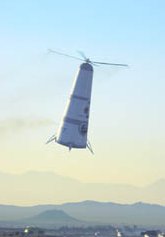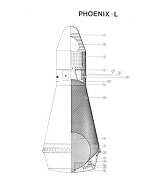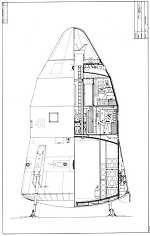Interview*
with Gary Hudson
Space
Entrepreneur & RLV Designer
*
via email
|
If you think
it's hard to convince people today that small private space companies
can do things that NASA can and can't do, you should have tried
it in the 1970s and the pre-Challenger 1980s. Though funding and
public interest in the US space program fell drastically by the
end of the Moon
Race, NASA's victory in that contest gave it tremendous
prestige and made it synonymous with all things space for many
years afterwards. The suggestion that a startup firm could develop
a large rocket vehicle of any sort was usually taken as a joke
or worse.
Nevertheless,
a few stubborn rocketeers made the effort. Robert
Truax, for example, proposed his suborbital space tourist
Volksrocket
in 1978. Gary Hudson wanted to go for a real spaceship.
One that you just get into, takeoff vertically, and go to orbit.
You should be able to return safely and repeat the flight within
a short time.
|
 Credits:
Tom Brosz
Credits:
Tom Brosz
Image of the original Roton design with rocket tipped rotors.
(Wired
- May.1996) |
|
Since the early
1970s he had studied designs for single-stage-to-orbit (SSTO) and vertical
takeoff and landing (VTOVL) reusable launch vehicles (RLV) like
those proposed
by Philip Bono. Gary thought they were within reach and by 1980 was
advocating
SSTO and
VTOVL approaches while everyone else was focused on the new Shuttle
program.
In 1982 he founded
a company called Pacific American Launch Systems that attempted to develop
a small commercial RLV. Unable to raise sufficient funding, the company's
Phoenix
never flew but Gary continued to pursue the development of SSTOs. In
1989 the Aerospace Corporation did a study of the Phoenix for Vice President
Dan Quayle's Space Policy Advisory Board. (Though the report was titled
Phoenix:SSX, the vehicle studied differed in several ways from
the SSX
design of the late Maxwell
Hunter). The positive judgement from that report helped to kickoff
the successful DC-X
demonstrator program of the early 1990s.
In 1996 Gary began
working with Bevin McKinney who had invented a radical SSTO concept
that used a rocket-tipped rotor propulsion system (Insanely
Great? or Just Plain Insane? - Wired - May.1996). The rotors provided
lift with the rockets and from the propeller effect while in the atmosphere.
Furthermore, the spinning would provide pumping action on the fuel and
thus eliminate the weight of separate pumps. The rotors would also provide
for a helicopter-like landing.
The company Rotary
Rocket was formed to pursue the Roton design and after it
raised enough funding to begin hardware development, the company attracted
a tremendous amount of attention. Several comsat constellation projects
in low earth orbit began around this time and they promised to provide
a solid market for a low cost vehicle that could carry replacement satellites
to orbit. Excitement grew that finally low cost access to space was
at hand. Unfortunately, when Iridium
and GlobalStar
went bankrupt, investment in Rotary and several other startup RLV companies
disappeared and Rotary closed in 2000. However, before the company shut
down, it did manage to test the rotor landing system with three low
altitude flights of the full scale ATV (Atmospheric Test Vehicle).
Since leaving Rotary,
Gary has pursued several projects via his firm HMX.
One project involved an interesting proposal
for supplying cargo to the ISS with a reusable capsule launched atop
an expendable Titan
II. Unfortunately, as discussed below, NASA was not enthusiastic
about the Alternate
Access to Space program and has not pursued any of the
AAS proposals.
I contacted Gary
via email to discuss the history and status of RLV development and to
hear about his current projects. The following is that interaction assembled
into a conversational interview format. [Note:
I've added links to some of the items that Gary discusses.]
|
|
HS:
I
once heard the physicist Richard Feynman make comments to the
effect that he felt extremely frustrated with the slow day-to-day
progress being made by theorists in developing a framework for
particle physics but when he stepped back and looked at the long
term, big picture, he was always surprised by the tremendous progress
that had been made.
You've
been working on private space related projects for decades now.
It must have been incredibly difficult to be taken seriously back
in the 70s and 80s when almost everyone took it for granted that
only NASA could do anything space related. I know that you are
very disappointed with all the setbacks of the past few years,
but when you compare today with the early days of private space
development, do you see substantial progress or do you feel like
we are still struggling just to reach the first rung of the ladder
to space?
Hudson:
: It is difficult to objectively answer this question. The last
few years have been rough for many of the players in the emerging
space industry, and often for varying reasons. I guess I would
have to say that I feel we have wasted decades and I am both frustrated
and angry about that waste.
|
Time is the one thing
we can't buy back. But I will admit that as each year goes by, the scale
of the task becomes easier to achieve, and I do believe that real progress
is being made. I am continually amazed by how much easier the job of getting
to orbit is today than even a few years ago. Software, avionics and manufacturing
technology have all improved measurably. This means that the number of
people required to design a launch system is continually declining, and
since manpower is the single highest cost of any development, this is
good news. Very good news, in fact.
In addition, the
interest in new projects seems to be increasing, and a heartening sign
is that people of means are funding their own projects, such as Elon
Musk (SpaceX) and Jeff
Bezos (Blue Origin).
|
HS:
When
the LEO constellation projects looked very promising in the mid-1990s,
suddenly there appeared 4 or 5 startup companies beginning to
design and build RLVs to provide replacement satellite services.
They faded away when their funding dried up after the constellations
went bankrupt. It seems clear to me that if Iridium, Globalstar
and Teledesic had been successful that we would have at least
2 or 3 low cost RLVs in operation today.
Yet
I still read comments from people in the mainstream aerospace
community stating that RLVs are out of reach with today's technology.
I've been amazed by the widespread acceptance, for example, that
the OSP will need 10 to 15 billion dollars and eight years of
development and even then start out with an ELV first stage.
I know you could say a lot about NASA and its internal politics
and culture in this regard, but why is it so hard to convince
the wider aerospace community of the viability of low cost RLVs?
|
|
Hudson:
Let me start
by saying that OSP is a joke. No sorry, that was too kind. It is an embarrassment.
NASA has totally screwed the pooch on OSP, and one hopes that if there
is any justice in Washington DC, they will be called to account and pay
a heavy price. The question remains, is there justice?
As for convincing
people of the merits of RLVs, I don't bother any longer. Those that
get it, get it. Those that don't, don't. Never the 'twain shall meet.
What amuses me is how all the major contractors in the SDIO SSRT program
of 1991 could show with confidence that VTOL, VTHL and HTHL SSTO would
work, some could show it could be accomplished in a few years time for
under $2B, and NASA could still fail to build the suborbital X-33 for
a similar amount of money.
Ultimately, someone
with the power of the purse needs to look NASA in the eye and ask why
every single space transportation project attempted by the agency since
Shuttle (X-33,
X-34,
X-37,
X-43,
X-38,
SLI and now OSP)
has either failed or been put on life support. And post-Columbia, I
might add Shuttle to that failed list.
It is really hard
to convince anyone a private team with a few percent of the cash and
1/100th the staff can do better, but history is replete with stories
of just how to do that. But first, to clear the air, someone needs to
spank NASA and send them to bed without their supper, metaphorically
speaking.
HS:
You
went to the GAO to protest the decision by NASA to reject the HMX proposal
for a flight demonstration contract under the SLI program. The legal
wording is a bit much for me but was the argument essentially that NASA
should order launch services, as instructed by the Commercial
Space Act, rather than insist on specifying the details of the vehicle
implementation? Though the challenge was denied,
do you feel you made your point?
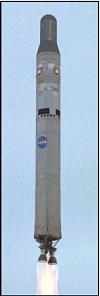 Credits:
Tom Brosz
Composite
image of an HMX XV Transfer capsule on a Titan
II to supply cargo to the ISS. Designed under the Alternate
Access to Space program.
Credits:
Tom Brosz
Composite
image of an HMX XV Transfer capsule on a Titan
II to supply cargo to the ISS. Designed under the Alternate
Access to Space program.
|
|
Hudson:
Thousands of words could be written about this matter (and
in fact were). When I read the GAO summary I wonder if they and
we are talking about the same case. Here is a brief summary of
the facts not in dispute.
NASA awarded
HMX a contract extension to a 2002 unsolicited $250K contract
meant to evaluate the feasibility of reusing Titan
II ICBMs in support of the NASA MSFC AAS program. The conclusion
of that effort, briefed in November 2001, was that the Titan could
be refurbished for AAS missions without significant risk and for
about $25 million per flight. HMX had assembled a team including
Aerojet, Universal Spacelines, United Paradyne and the Virginia
Space Flight Center (Wallops) to accomplish this task. This price
per flight was consistent with current manpower loading costs
used by Lockheed-Martin for the USAF Titan II SLV program, and
all savings over the current Titan costs were well accounted for
through the purchase of off-shore propellants, use of modern flight
guidance and avionics systems plus lower launch costs at Wallops
vis Vandenberg. NASA concurred in the finding and the X-37 Program
Office then awarded us a further $250K extension to determine
if the Titan II could be used to launch the X-37. We performed
that work in cooperation with Boeing Phantom Works (BPW), which
received a similar study contract. Both Boeing and HMX concluded
that the Titan II could launch the X-37, unshrouded (this is a
key point to remember).
The X-37 Program
Manager of the date was highly enthusiastic and really wanted
to implement the X-37 option. BPW concluded that the Delta
II really couldn't do the job and so baselined the HMX option
as their primary launcher. HMX also bid a test flight to qualify
the stack using a dummy X-37 aeroshell under the TA-10
NRA proposal (part of the SLI effort). Once flown with the
dummy payload, the Titan II would have been qualified to launch
the X-37 orbital vehicle.
|
During the proposal
effort, as permitted under the terms of the NRA solicitation, HMX regularly
engaged in dialogue with NASA MSFC. At one point we informed MSFC that
it was our intention to take advantage of a specific clause in the request
for proposal that permitted the contractor (HMX) to take "exception
and propose deviations" to the form and substance of the NRA TA-10.
We did so, explaining that we were going to bid without detailed cost
and pricing data, as permitted under the Commercial Space Act of 1998.
(Kistler Aerospace had done exactly the same the year before in their
successful bid for a TA-10 contract, so we felt we were on firm contractual
ground.) Shortly thereafter we received a formal call from the MSFC
Contract Office informing us they would not respond to our inquiry (a
violation of the NRA rules) and that they would entertain no further
discussion with us (also a violation of the rules). The supportive TA-10
Program Manager was reassigned to a new job by Dennis Smith, then SLI
Program Manager and now, interestingly enough, the architect of the
OSP project. In spite of this negative turn of events, we still made
our proposal (and a subcontract proposal for Boeing) since it was too
late to do anything else. A few weeks later, we submitted our bid.
The bid was rejected
on two principal grounds. One was our refusal to give cost and pricing
data, which the law specifically excludes. The other was a technical
and schedule objection. NASA made several grievous technical errors
(getting the payload to orbit mass wrong by many hundreds of pounds
being just one) and made schedule objections which were ludicrous. In
one case the GAO quoted NASA as saying the Titan IIs could not be refurbished
as fast as we planned because they had been in the desert for 15 years
without maintenance, when NASA knew they were kept in pristine condition
with regular maintenance by a team of USAF technicians. NASA knew this
because they had accompanied HMX to visit the Titan storage facility.
In any case, MSFC
refused to give us the award and directed the unwilling BPW to use the
Delta II. Of course, only a year later, they have had to abandon Delta
II since it can't perform the mission, and are now proposing a hugely
more expensive shrouded Delta IV flight. Industry observers, commenting
recently in Space News, wonder: why bother flying the X-37 under a fairing
and what in the devil that will teach us about flying an OSP? Of course,
it is only a mater of time before MSFC kills X-37 altogether.
HS:
I
assume that weight growth had pushed the X-37 beyond the Delta II
even if it flew unshrouded?
Hudson:
My understanding was that there was no weight growth, though NASA
claims this to save face. I have the original X-37 Boeing weight numbers
and I know exactly how much margin they are holding back from NASA.
I am fairly sure the thing that torpedoed the plans to use Delta II
was that it couldn't take the loads imposed by the winged X-37 on
top of the stack, unlike the Titan II, which we showed could handle
the loads. The Delta II has a high acceleration profile (from the
solids) and probably also overheated the X-37, but of that I am not
certain.
Frankly, the only
reason why X-37 has lived as long as it has was due to pressure from
Chairman Dana Rohrabacher. MSFC knew they would have to keep X-37 alive
until he left his subcommittee chair in fall 2002, but they didn't count
on the Columbia accident and the house waived term limit rules to bring
the Chairman back. So now they are in a pickle.
Finally, I can answer
your question! I do feel we made our point, even if GAO completely missed
it. (GAO said we should have protested prior to proposal submission,
a nice theory that fails the test of sanity in the government procurement
process.)
HS:
There
doesn't seem to be much of a tradition of investigative journalism
within the aerospace press. When you talk about your case and the
X-37 situation, it reminds me of the X-34 cancellation, which I saw
as an outrage if not a scandal. As I understand it, in the aftermath
of the two Mars mission failures, all major projects got hit with
system reviews to avoid any more embarassing public disasters. For
the X-34, they added so many additional safety requirements that it
crossed their cost limit and so was canceled. This happened even though,
in traditional X project spirit, Orbital had built 3 vehicles just
so it would have backups if one was lost. In addition, NASA had required
that they use the Fastrac engine, which as far as I know, was a project
that simply faded away without ever flying an engine or making any
public accounting whatsoever.
You
surely know more about what really happened in these cases than I
do. However, the fact that I have to guess as to what happened [in
these and your cases] rather than go to a NASA web page and read a
clear and full summary of such projects [and how decisions regarding
them were made] absolutely amazes me. And I'm even more amazed that
the aerospace press lets them get away with it.
Hudson:
You have the story exactly right, insofar as I am aware. While I am
not a fan of Orbital, I have often taken their side in the X-34 matter.
NASA MSFC needs a through housecleaning and it requires a persistent
and competent press to get Headquarters or the Congress to do their
job.
|
HS:
Whether
to go directly to SSTO rather than two-stage to-orbit (TSTO) in
the first generation of RLVs leads to big arguments. I recall
that you said that if the Roton's payload capability came in short
of its goal, boosters could always be attached to compensate.
Would this approach in general be a good compromise? That is,
build a SSTO that can put some minimal payload into orbit but
allows for the option of either expendable boosters or a reusable
first stage whenever a heavier payload is needed.
Hudson:
Adding
a Delta V increment of just a thousand feet per second makes SSTO
much easier. (I have been often overheard bemoaning the fact that
we don't live on a planet of Venus' size; SSTO would be easy.)
The way to accomplish augmentation, in my view, is not to build
some type of "zero-stage" but rather treat the problem as one
of an aircraft range extension or takeoff roll reduction. Add
drop tanks or RATO
|
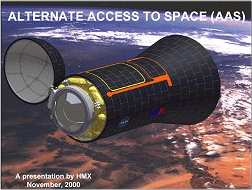
Credits:
Tom Brosz
The
HMX XV Transfer vehicle
proposed for ISS cargo delivery under the Alternate Access
to Space program. |
|
| kits.
If they are cheap enough, you punch them off like fighter drop tanks.
If they are a bit more expensive, recover them as the WWII Germans
did with some of their rocket-assist motors. This is pretty easy
stuff, frankly. One mistake I made during the Rotary project was
not telling people that it was actually a stage-and-a-half vehicle,
and then never bothering to add the "half" unless really needed. |
Max Hunter used
to tell me that the thing that killed the cost effectiveness of the
Shuttle was the decision to use solid boosters, but not for the operational
reason as you may surmise. The addition of the boosters made everyone
lazy. If the Shuttle had been configured as his Starclipper stage-and-a-half
concept, with the only expendable part a drop tank for the hydrogen,
then the design might have been successful. If boosters were ever needed
they would be an afterthought such as the Atlas II strap-ons, and most
likely temporary while efforts were made to lighten up the expendable
tank or the reusable orbiter. That would have been the smart way to
go.
HS:
A stage & half approach
certainly is a nice third option to point to. Have you ever written
anything up on this? If not, please do.
Hudson:
One more task to go on the to-do list!
HS:
If you were given $300 million
today to build a RLV, would you still go with the basic Roton approach?
|
|
Hudson:
No. The Roton project was one of those train wrecks where everyone
can see the bridge is out but the engineer can't slow the train
down in time. And other people are throwing the switches.
Bevin's original
or "classic" Roton was a fun, cool idea. Using self-pumping and
some aerodynamic lift augmentation up to about Mach 1.3, it could
have performed the X-prize mission or put a couple of people and
a ham sandwich into orbit. One feature that was particularly appealing
was that the ascent lift augmentation (about 25-30 seconds Isp)
paid for the weight of the rotor on orbit, and the rotor could
be used to aid re-entry and provide soft, controllable landings.
We felt that was a big win.
|
After
we found funding for that vehicle, we also found ourselves in the position
that our initial funds would not see us to flight, far from it. And
our prime investor told us at the outset that we had to find other investors
to fund the rest of the development. That was OK by me, and off we went.
But we could not find any other investors willing to build a small piloted
vehicle mainly configured for human spaceflight and small cargo, and
were forced to either close our doors or retool the concept to meet
the need for LEO comsats. The classic Roton might have been able to
fly some of the early LEO spacecraft designs, one spacecraft at a time,
but soon those grew in size many-fold and instead of a thousand pounds
to LEO, we were facing 7000 pounds. The classic couldn't do that, and
so the Roton everyone knows emerged. In hindsight, we'd have been better
off walking away then, but no one suggested we do so.
HS:
In
retrospect, are there any fundamental aspects of the Rotary Rocket project
that you would do differently if you could do it over again?
Hudson: My
response to the previous question touched on this, but I think that
this subject is probably best left for another forum, such as a book.
Short answer is yes, there are many things. A few key points: One is
never start a project in the public eye that doesn't have all the cash
in hand before you go public. (I might even amend that to wait until
you are starting to fly before you go public!) Another is don't split
your operation in two (in our case, the Bay area and Mojave). Third
would be to control your hiring process carefully. A few hiring mistakes
can consume huge amounts of management time to fix or mitigate damage.
Having said all
that, I am still very proud of the accomplishments of Rotary Rocket.
We designed and flew, in one year's time, a full-size, piloted Roton
demonstrator, that showed a lightweight SSTO with composite LOX tanks
could in fact be in built. It was the only flying RLV demonstrator since
DC-X. None of NASA's (or should I say the taxpayer's) billions produced
anything that flew with humans.
|
HS:
I
remember at your Roton presentations that when someone suggested
a change to a particular component, you would explain how that
would result in serious, usually detrimental, consequences to
several other components and vehicle performance. Everything is
so tightly interlocked on RLVs, especially SSTO designs. Although
propulsion and low mass structures are obviously crucial, is the
toughest challenge of RLV development not so much with the individual
technologies but with the system engineering that must "assemble"
a coherent design that performs well in all the different flight
regimes, is robust enough for multiple flights, and provides for
low operational costs?
Hudson:
Absolutely. This is why NASA has failed in all its attempts to
date. They no longer have any artists, only managers. Systems
engineering is an art, not a science. Folks like Kelly Johnson
and Burt are aircraft artists. They blend equal parts vision,
engineering and intuition to make successful design. Of course,
in doing so, they also produce some stinkers. That is the price
of this approach. The current industry doesn't select for such
individuals, and I can see no way that it ever will.
|
|
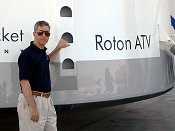
Gary
Hudson at the base of the Atmospheric Test Vehicle.
|
|
HS:
My
impression is that you have not been exactly thrilled with RLVs for
suborbital operations and skeptical of a suborbital space tourism market.
Has your outlook changed? If that market does prove viable, say at the
hundred million dollar a year level, will the suborbital RLVs provide
valuable operational experience in running routine flights and substantially
reduce the risks in the design of orbital vehicles?
Hudson: There
are two basic suborbital markets for RLVs. One is passenger flights
and the other is microgravity or science mission of one sort or another.
There is a third large proven market for suborbital launches, but one
that is -by definition-not addressable by an RLV. (Targets for missile
defense.)
I think the microgravity
market is completely overrated. This is an area of research which has
borne fairly little fruit, and which is unlikely to do so for a long
time to come, if ever. And if there is a payoff, it will almost certainly
come from long duration human tended freeflyers where the disturbing
torques of human presence don't exist and the microgee goes on forever.
As always, I am happy to be proven wrong by events and wish those who
are going after such markets well, but I am definitely in the "show
me" camp on this.
HS:
There are novel
and interesting phenomena seen in the microgravity studies but even
if you found something as revolutionary as, say, carbon buckyballs
and nanotubes, you are still talking about hundreds if not thousands
of personyears of lab work, both in orbit and on the ground, to get
something useful out the door. So I would never try to justify a space
station or even a suborbital program purely on micrograv research.
However,
I think there are a number of science applications that could take
advantage of a reusable suborbital. A top recommendation by a Space
Studies review committee of the the National Academy of Sciences recently
asked that NASA "revitalize the Suborbital program". I think RLV suborbitals
could certainly do that. They are potentially cheaper than sounding
rockets, they offer frequent, predictable access to space and carry
a person on board to monitor the equipment. Some astrophysics experiments
can run even on short flights and sensors intended for a probe could
be tested and calibrated before they fly. Magnetospheric experiments,
atmospheric studies, and remote sensing could also be done very well
on such a platform.
I'm thinking it could be in the $100 million market range, which isn't
much compared even to a [single] comsat but it would offer some nice
extra income for a small startup RLV company.
Hudson:
All of the money for microgravity and science work essentially comes
out of the same pot. And the pot is pretty small. Those funds have
to cover the work as well as the transportation, too. So I would guess
that there may be $15-25 million per year for suborbital micro-gee
flights and other science, at most. I'd be happy to be proven wrong,
yet it is hard to make a business case in my view for such services
unless something else (such as tourism) is really paying most of the
operating expenses.
I've spent thirty-plus
years in the business and I can tell you that every two years someone
comes along and promises to make money off the suborbital government
launch market. Hasn't happened yet.
Are there people
who will pay for a suborbital joyride? Certainly. Might there be a $100M/year?
I think that is more problematical. Once the ZERO-G
aircraft people get flying, let's see how many people pay for that experience.
While not a fully comparable ride, it will also be two orders of magnitude
cheaper. That will tell us something. In the end, I think it possible
that companies can make money in this market, but I am uninterested
in it for myself or HMX. Too many entrants and too much risk. And not
enough connection to why I got into this business: to open the space
frontier. To me, that means orbit and beyond.
HS:
I
guess you know from RLV News that I'm more optimistic about the business
case for suborbitals than you are. However, I certainly don't think
it's a sure thing. Besides the regulations and liability challenges
to overcome, the marketing for the suborbital tourism will need to
be done right.
I
think something along the lines of Ed Wright's space training camp
approach might be the way to go. During a one or two week stay the
participant would take part in various simulations and other astronaut-like
training activities such as a ride on a ZERO-G flight. Everything
builds up to the ride on the rocket. The fact that the ride only lasts
an half an hour or so will matter less if it is seen as part of a
overall space training experience.
HS:
What do you think of the current
leading X PRIZE designs
such as Burt Rutan's SS1,
Armadillo's
vertical takeoff with parachute landing, etc.? If someone hired you
to work on an X PRIZE project, what design approach would you favor?
|
|
Hudson:
I don't propose to handicap any entrant. In Burt's case, HMX is
under NDA; we helped him originally choose hybrid motors (based
on Bevin's unparalleled experience with them) and we have provide
him technical consulting. So beyond saying the obvious-that as
usual, his is a highly innovative approach-I think I will let
events take their course. I will offer my best wishes to one of
his test pilots, however, Brian Binnie, who was in the co-pilot's
seat when the Roton ATV flew down the runway at Mojave back in
1999. Brian is one of the finest men I have had the pleasure to
work with. Burt is lucky to have him.
I love the
"go out and do it" approach of Armadillo and think that several
of the other contenders have much to recommend themselves. As
for the way I would approach the problem, it depends on a number
of factors. One is are we just trying to win the price or is there
supposed to be residual operational value to the vehicle produced?
And is operating cost or development cost the paramount consideration?
I think I
might choose a winged vehicle, runway launched, using Bevin's
CoolJet™ turbine accelerator (something like the MIPCC [Mass
Injected Pre-Compressor Cooling] engine proposed for the RASCAL
project at DARPA). The technology is well in hand and is relatively
low risk for the Mach number of interest for the X-prize.
|
HS:
Sounds very interesting. Anything on the
web about the CoolJet?
Hudson: Not
yet. Some patent work is in process, and the actual press of day to
day business has meant that we never get around to the web site. It's
still on the to-do list, too!
HS:
Can you say something about the projects you are currently working on?
Hudson: HMX
has finished our AAS activity for NASA MSFC (and we are unlikely to
be doing more for them.) We have performed some SBIR work for DARPA
on CoolJet, and recently supported Pioneer
Rocketplane in their (unfortunately) unsuccessful bid to move into
Phase II development on the RASCAL program. (That contract was won by
some of my former employees, who started Space
Launch Corporation.) And we are currently hard at work on a big
effort for DARPA to build a test bench to qualify MIPCC modifications
to an F-100 class turbofan engine under Mach 3+ conditions.
As always we maintain
an interest in the commercial launch business, but we are not funded
to do anything about that. Frankly, no more venture capitalists or investment
bankers for me; we are happy to work for others as contractors but we
aren't going to play the investor game again. There is too much of a
disconnect between the interests of investors and customers for most
such projects to have a reasonable chance of success. In mathematical
terms, there is very little intersection of the sets in that particular
Venn diagram.
Finally, we continue
to refine the XV (Transfer Vehicle) concept we proposed to NASA under
the Alternate Access program. Someday, someone may want to build such
a system and we want to be prepared to do it if asked. In closing, it
is amusing to note that if NASA had not bungled the AAS program, we'd
have been flying Titans to the station this very year, and not a moment
too soon post-Columbia, while having a system that met, in 2000, every
single one of the Level One requirements NASA imposed on the OSP earlier
this year.
Talk about missed
opportunities! It seems to be the story of my life.
HS:
Well, it's certainly looks
like an interesting life so far (and I don't mean that in the Chinese
curse sense either!) Best of luck with your current and future projects.
Thanks.
Jerry
Pournelle offers a background of SSTO/VTOVL concepts
in the 1980s via his report The
SSX Concept.
The RLV
History section includes links to papers
by Gary Hudson
and links about Rotary
Rocket.
See a video
of the ATV's last flight on Oct.12, 1999.
Several former Rotary Rocket personnel have started new space related
companies including Space
Launch Corporation and XCOR
Aerospace.
You can contact Gary Hudson at gary@hmx.com.
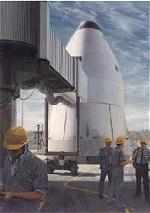
Credits: Paul Hudson
Phoenix SSTO concept from 1985:
History
of the Phoenix ...- reprint at Space Future
Notes/Feedback
June.11.03.
Comments
by Rand Simberg at Transterrestrial Musings on this interview.
|

